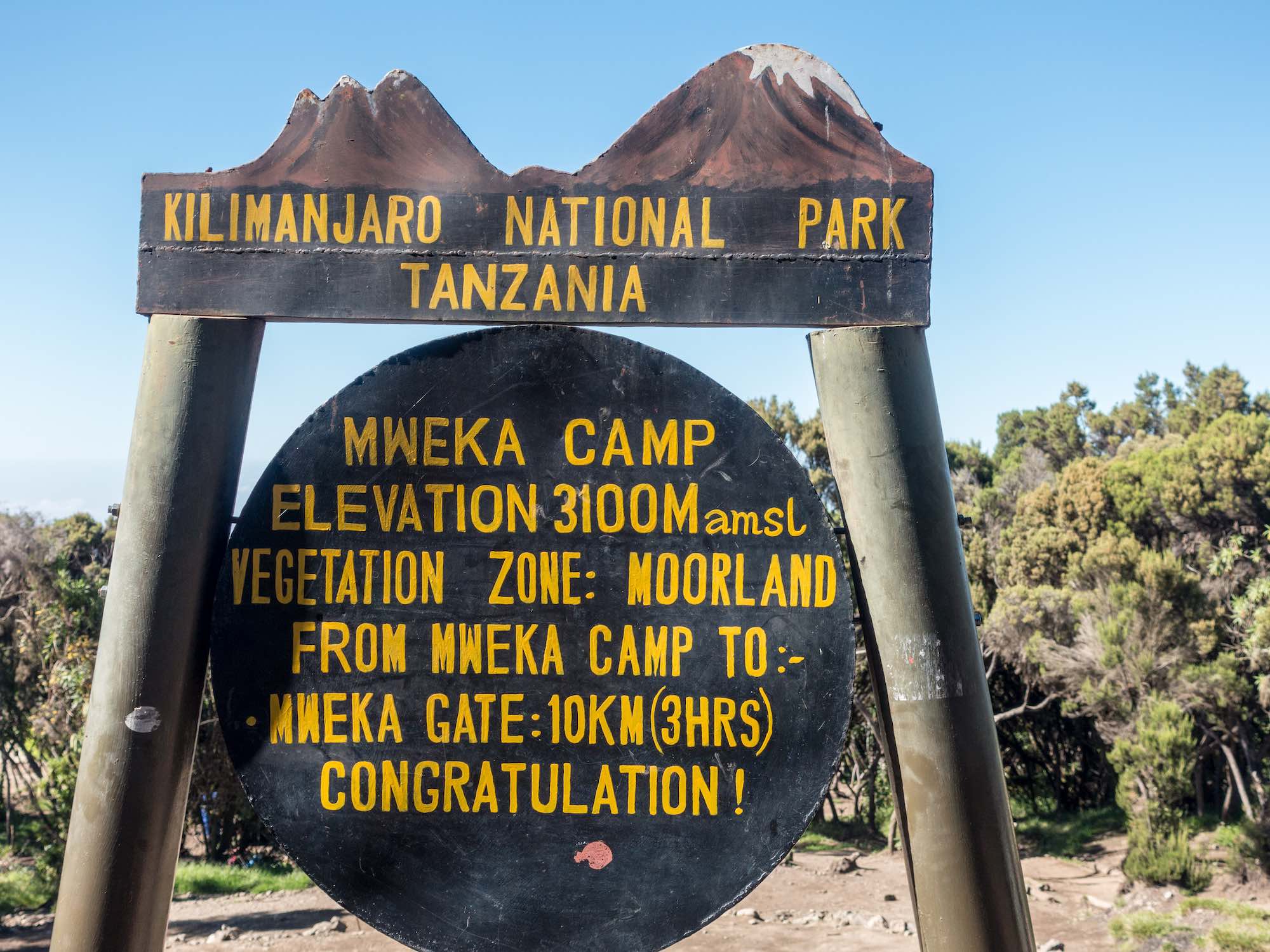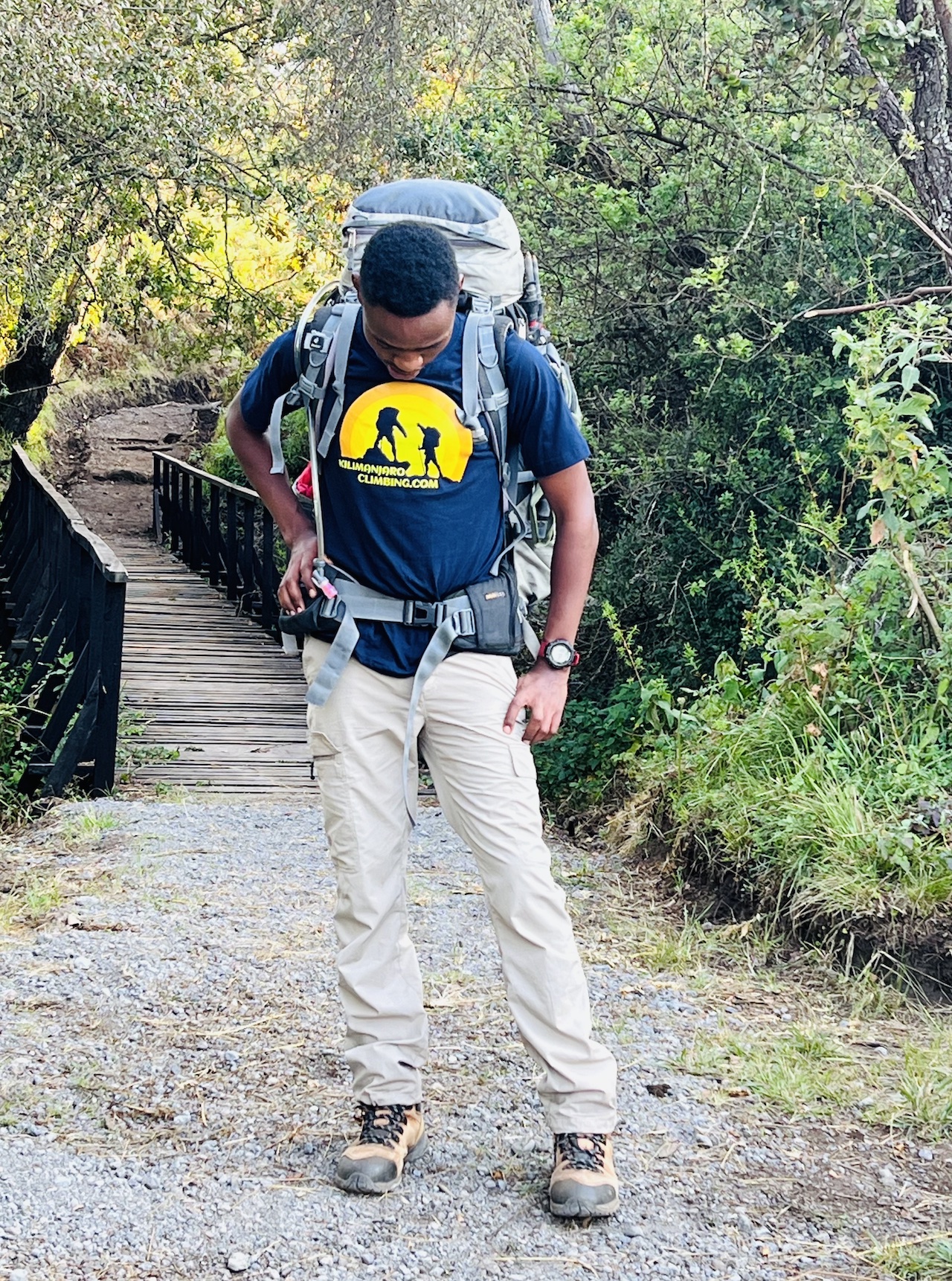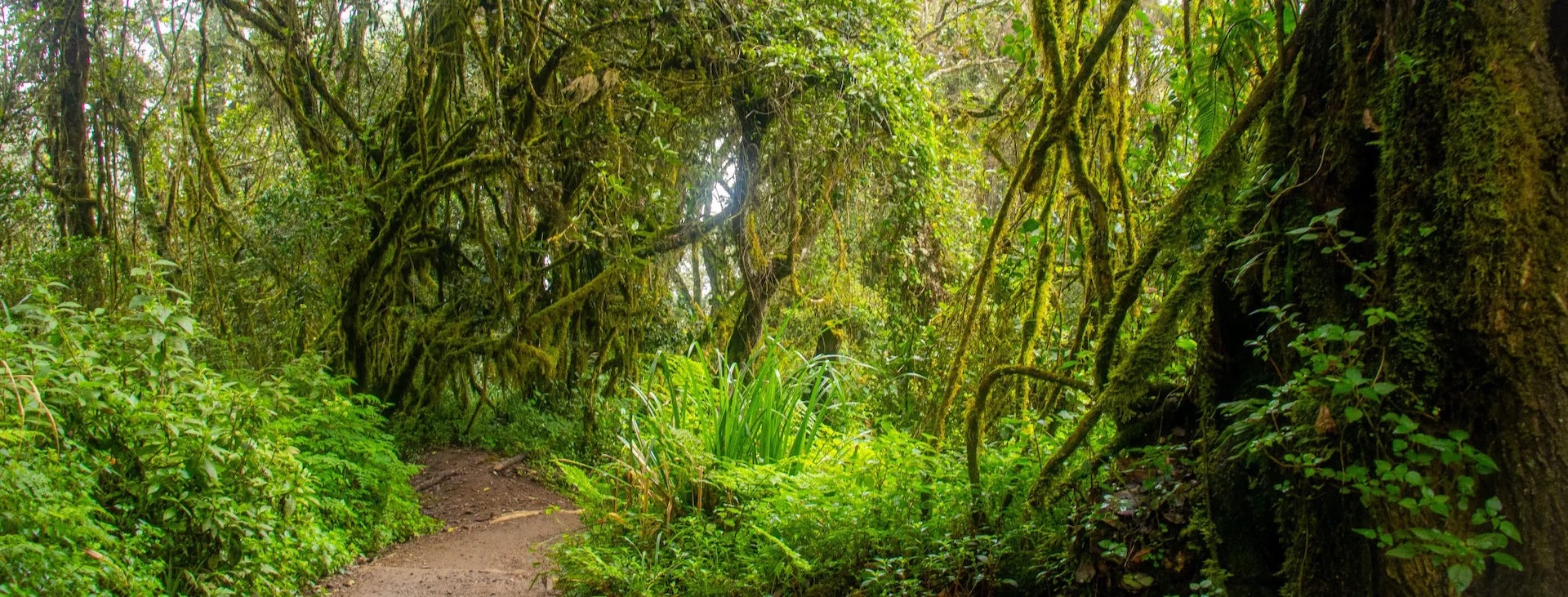The Mweka Route is often hailed as the unsung hero of Mount Kilimanjaro’s climbing experience. Unlike other famous trails like the Machame Route or Marangu Route, the Mweka Route is exclusively used as a descent path, providing trekkers a scenic and relatively quick journey down the southern slopes of the mountain. After summiting Kilimanjaro at Uhuru Peak, most trekkers find themselves making their way down via this path, which offers its own kind of beauty—one that contrasts the icy, rocky summit with lush rainforest and vast views of the African plains below.
Though it’s not typically used for ascending, the Mweka Route plays a critical role in the Kilimanjaro experience, offering a well-maintained, straightforward, and rewarding exit route that allows climbers to reflect on their monumental achievement while surrounded by the natural wonders of Kilimanjaro’s lower slopes.
Why the Mweka Route, Kilimanjaro is Important
The Mweka Route is primarily used for descent on several Kilimanjaro trails, including the Machame, Lemosho, Shira, and Umbwe Routes. As a descent-only path, it’s designed to give climbers a fast and direct route off the mountain after they’ve reached the summit. Most climbers descend to Mweka Camp after summiting and then continue to Mweka Gate, where the journey ends.
Benefits of using the Mweka Route for descending
- Faster Descent: After reaching the summit, the Mweka Route provides a quicker descent compared to other trails. This is crucial in helping trekkers adjust to lower altitudes more rapidly and minimize the risk of altitude sickness.
- Well-Maintained Path: The route is well-established and maintained, making it a safer option, especially after the physical toll of summiting.
- Scenic Diversity: Although the path is primarily for descent, trekkers get to enjoy diverse scenery, from alpine desert down into lush rainforests, making the journey back to lower elevations just as scenic as the climb up.
Mweka Route: Step by Step From Summit to Rainforest
 After summiting Uhuru Peak, trekkers typically begin their descent in the early morning, following a steep, often loose trail down from the summit. The descent can be physically demanding, especially after the exhaustion of summit night, but it offers stunning views of the surrounding landscapes that make it worthwhile.
After summiting Uhuru Peak, trekkers typically begin their descent in the early morning, following a steep, often loose trail down from the summit. The descent can be physically demanding, especially after the exhaustion of summit night, but it offers stunning views of the surrounding landscapes that make it worthwhile.
- High Alpine Desert: The Mweka Route begins in the high alpine desert zone near Barafu Camp or Stella Point, where the rocky, barren terrain contrasts sharply with the snow-capped summit above. Trekkers descend from this stark, lunar-like landscape with sprawling views of the Great Rift Valley and the lowland forests stretching out below.
- Moorlands: As climbers descend, they enter the moorland zone, where unique plants like the Giant Senecio and Lobelia thrive. This zone provides a gentle reminder of the lower altitude, and the change in flora is refreshing after the barren upper slopes.
- Rainforest: One of the most beautiful aspects of the Mweka Route is the transition into the lush rainforests on the lower slopes. As trekkers enter the forest, they are greeted by towering trees, vines, and the sound of wildlife, from birds to monkeys. The air becomes humid, and the trail can be muddy at times, but the richness of the landscape is captivating after days in the sparse, high-altitude zones. Trekking poles are highly recommended to navigate the sometimes-slippery trails in this section.
The change in climate and scenery is rapid on the Mweka Route, giving climbers a chance to reflect on the variety of ecosystems they’ve passed through during their Kilimanjaro trek. This zone is particularly special as it marks the end of the journey through Kilimanjaro’s famous five climate zones, each as unique and awe-inspiring as the last.
Mweka Camp: A Well-Deserved Rest Stop
Most climbers will stop at Mweka Camp (3,100 meters/10,170 feet) after summiting and descending from Barafu. After the long and exhausting summit push, Mweka Camp provides a much-needed break. Located in the lower part of the mountain, the camp is set amidst thick rainforests, offering trekkers a peaceful rest in a scenic environment. This camp is usually bustling with climbers celebrating their successful summits, sharing stories, and relishing the experience of having reached the top of Africa.
Facilities at Mweka Camp are basic but functional, with plenty of space for tents and a communal dining area. For many, the stop at Mweka Camp is a time to relax, reflect, and recover before the final leg of the descent to Mweka Gate.
Mweka Gate: The Final Stop on the Kilimanjaro Journey
The journey ends at Mweka Gate, located at an altitude of 1,640 meters (5,380 feet), where climbers check out of Kilimanjaro National Park. Here, trekkers receive their summit certificates, proudly marking their achievement of reaching Uhuru Peak. There are two types of certificates:
- Green Certificates for those who reached Gilman’s Point (5,685 meters)
- Gold Certificates for those who reached Uhuru Peak
The area around Mweka Gate is typically lively, with trekkers celebrating, guides and porters offering congratulations, and local vendors selling souvenirs. It’s the perfect place to take a final group photo and reflect on the adventure before heading back to Moshi or Arusha.
Mweka Route and Altitude Considerations
 While the Mweka Route is primarily used for descent, it is important to note that altitude sickness can still be an issue during the descent. Climbers are often coming down from over 5,800 meters (19,000 feet) in a relatively short period, so it’s crucial to maintain a steady pace, stay hydrated, and be mindful of how your body is feeling.
While the Mweka Route is primarily used for descent, it is important to note that altitude sickness can still be an issue during the descent. Climbers are often coming down from over 5,800 meters (19,000 feet) in a relatively short period, so it’s crucial to maintain a steady pace, stay hydrated, and be mindful of how your body is feeling.
Because the Mweka Route facilitates a rapid descent, it helps reduce the time spent at high altitudes, which minimizes the chances of developing severe altitude sickness, making it a safer option for descending climbers.
How to Prepare for the Descent on Mweka Route
Descending Kilimanjaro can be just as demanding as the ascent, so it’s important to be well-prepared. Here are a few tips to help you prepare for your descent via the Mweka Route:
- Trekking Poles: These are essential for the descent, particularly in the rainforest where the trail can be muddy and slippery. Poles help reduce the strain on your knees and improve balance.
- Proper Footwear: Ensure your boots are comfortable, broken in, and have good traction for navigating the steep and often loose trails.
- Stay Hydrated: Just because you’re descending doesn’t mean hydration is less important. Drink plenty of water to stay energized and alert.
- Pace Yourself: Descending rapidly can be hard on your knees and muscles, so take your time and don’t rush down the mountain.
- Celebrate: After the physical and mental challenges of reaching the summit, the descent is the time to enjoy your achievement. Take photos, savor the views, and celebrate the journey.
Read about other all other routes for climbing mount Kilimanjaro.
Mweka Route, the final Descent on Mount Kilimanjaro
Though it is rarely chosen as an ascent route, the Mweka Route is an integral part of the Kilimanjaro experience. As you descend, you’ll witness how the landscapes transform before your eyes, moving from the barren heights of Kilimanjaro’s upper reaches to the lush rainforests of the lower slopes. This scenic and fast descent offers a beautiful, reflective journey down the mountain—a peaceful counterpart to the intense challenge of reaching Uhuru Peak.
For many climbers, the Mweka Route symbolizes the completion of their Kilimanjaro journey. While the ascent to Uhuru Peak is the highlight of the trip, the descent through the Mweka Route offers time to absorb and reflect on the experience. As you trek through the stunning scenery and make your way to Mweka Gate, the entire journey comes full circle. The sense of accomplishment, the connection to nature, and the memories forged on the mountain will stay with you long after you leave Kilimanjaro behind.
FAQs About Mweka Route, Mount Kilimanjaro
-
What is the Mweka Route on Mount Kilimanjaro?
The Mweka Route is a popular descent-only route on Mount Kilimanjaro. It is primarily used by climbers on routes like the Machame, Lemosho, and Shira Routes to descend from the summit.
-
Can I ascend Mount Kilimanjaro using the Mweka Route?
No, the Mweka Route is designated only for descending. Climbers typically use it to return after summiting via routes like Machame or Lemosho.
-
How long does it take to descend using the Mweka Route?
Descending via the Mweka Route usually takes 1 to 2 days, depending on the climber’s pace and the conditions. Climbers typically stay at Mweka Camp before descending to Mweka Gate.
-
Where does the Mweka Route start and end?
The Mweka Route begins at the summit area, descending first to Mweka Camp at 3,100 meters (10,170 feet), and then continuing to Mweka Gate at 1,640 meters (5,380 feet).
-
What is the terrain like on the Mweka Route?
The Mweka Route descends through several climatic zones, starting in the alpine desert at high altitudes and moving into the lush, misty montane forest. The trail can be steep and slippery, especially in the forested areas.
-
Is the Mweka Route difficult?
While the Mweka Route is primarily used for descent, it can still be challenging. The rapid drop in altitude, combined with steep and sometimes muddy paths, requires careful footing. Trekking poles can be very helpful.
-
Do you need to acclimatize for the Mweka Route?
Acclimatization is more relevant for the ascent routes. However, descending quickly from high altitudes can also be demanding, so climbers should take their time, especially if feeling fatigued.
-
Are there any camps along the Mweka Route?
Yes, the main camp along the Mweka Route is Mweka Camp, located at 3,100 meters (10,170 feet). It serves as the last overnight stop for climbers descending from the summit.
-
What facilities are available on the Mweka Route?
Mweka Camp offers basic facilities such as tent sites, restrooms, and water sources. However, amenities are limited, and climbers should bring their own supplies.
-
Is the Mweka Route crowded?
The Mweka Route can be busy during peak climbing seasons, as it serves as the primary descent path for several routes. However, climbers are generally spread out, so it doesn’t feel overly congested.
-
How do I prepare for the descent on the Mweka Route?
Ensure you have trekking poles for stability on steep or slippery sections, wear comfortable footwear for the descent, and stay hydrated. Descending can be hard on the knees, so pacing yourself is important.
-
How far is the hike from Mweka Camp to Mweka Gate?
The hike from Mweka Camp to Mweka Gate is about 10 kilometers (6 miles) and takes approximately 3 to 4 hours. The trail passes through the montane forest and can be muddy, particularly after rain.
-
Which routes descend through the Mweka Route?
The Mweka Route is used as the descent route for several popular Mount Kilimanjaro climbing routes, including the Machame, Lemosho, Shira, and Umbwe Routes. Climbers use these routes for ascent, and after summiting at Uhuru Peak, they descend through the Mweka Route to reach Mweka Gate. This descent option helps reduce congestion on the mountain and allows climbers to experience different parts of Kilimanjaro’s diverse landscapes.

